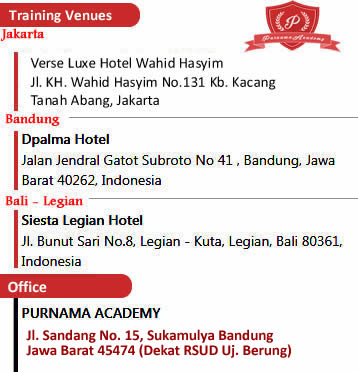Syllabus
MySQL For Database Administrators
Class Type : Training
Duration : 5 Days (09.00 – 16.00)
Training Description :
Pelatihan MySQL for Database
Administrator ini adalah program pondasi bagi para DBA mysql. Training
mengajarkan para administrator database
dan pengembang cara menggunakan basis data yang powerfull ini, selain
itu juga peserta megetahui tugas tugas seorang DBA secara mendetail.
Prerequisites :
- Telah
menggunakan MySQL secara aktif
Topic Includes :
Introduction
Describing MySQL
Listing MySQL Products and Professional Services
Describing MySQL Enterprise Subscription Currently
Supported Operating Systems
Describing MySQL Certification Program
Listing Available MySQL Courses
Describing Installation of MySQL
Describing Installation of world Database
MySQL
Architecture Client/Server Architecture
MySQL Architecture
Overview How MySQL Uses Disk Space
How MySQL Uses Memory
The MySQL Plug-In Interface
The
MySQL Server
Types of MySQL Distributions
Starting and Stopping MySQL on Windows Starting and
Stopping MySQL on Linux Upgrading MySQL
Managing Multiple Servers
Configuring
the MySQL Server
MySQL Configuration Dynamic Server Variables Server
SQL Modes
Log and Status Files Binary Logging
MySQL
Clients
Overview of Administrative Clients
Invoking MySQL Client Programs Using the mysql
Client
The mysqladmin Client
MySQL Connectors Third-Party APIs
Overview
of Data Types
Data Types
Numeric Data Types Character
String Data Types
Binary String Data Types
Temporal Data Types NULLs
Column Attributes
Metadata
Metadata Access Methods
The INFORMATION_SCHEMA Database/Schema Using SHOW
and DESCRIBE
The mysqlshow Command
Storage
Engines
Storage Engine Overview
MyISAM, InnoDB, and MEMORY Storage Engines Other
Storage Engines
Choosing Appropriate Storage Engines Using Multiple
Storage Engines Storage Engine Comparison Chart
Partitioning
Overview of Partitioning and reasons for using
Partitioning Creating a Partitioned Table
Obtaining Partition Information Modifying and
Removing Partitions
Partition Modification Performance Effects Partition
Pruning
Storage Engine Partition Information Partitioning
and Locking and Limitations
Transactions
and Locking
Transactions
Transaction Control statements Isolation Levels
Locking
Security
and User Management
Security Risks Security Measures Privileges
Access Levels, including: 1 - User Accounts, 2 –
Databases, 3 – Tables, 4 – Columns, 5 - Stored Routines User Account
Maintenance
Client Access Control Using Secure Connections
Table
Maintenance
Table Maintenance
SQL Statements for maintenance operations Client and
Utility Programs for table maintenance
Table
Maintenance per Storage Engine
Exporting and Importing Data
Exporting and Importing Data
Exporting and Importing Data Using SQL Import Data
with the SQL scripts
Programming
with MySQL
Defining, Executing and Examining Stored Routines
Stored Routines and Execution Security
Defining, Creating, and Deleting Triggers Trigger
Restrictions and Privileges Defining Events
Schedule Events
DBA's Use of MySQL Programming Backup Stored
Routines
Views
What is a view? Creating Views Updatable Views
Managing Views
Backup and Recovery Planning for Recovery Backup
Backup Tools Overview Making Raw Backups
Making Logical (Text) Backups Backup Log and Status
Files Replication as an Aid to Backup Backup Method Comparison Data Recovery
Introduction to Performance Tuning Using EXPLAIN to
Analyze Queries General Table Optimizations
Setting and Interpreting MySQL Server Variables
Introduction
to High Availability
MySQL Replication








































0 comments:
Post a Comment
Terima kasih telah mengunjungi halaman website kami, Jika ada pertanyaan terkait informasi di Atas silahkan isi Comment Box di bawah ini, Tim kami akan merespon komentar/ pertanyaan Anda paling lambat 2 x 24 Jam
Untuk respon cepat silahkan hubungi 0838-0838-0001 (Call/Whatsapp)
Regards,
Management,
www.purnamaacademy.com